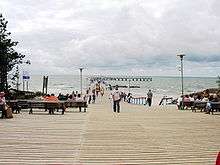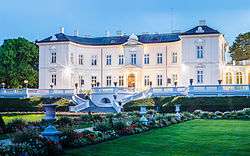Palanga
| Palanga | ||
|---|---|---|
| City municipality | ||
|
The Tiškevičiai Palace houses the Amber Museum | ||
| ||
| Nickname(s): Vasaros sostinė (Summer Capital) | ||
 Palanga Location of Palanga | ||
| Coordinates: 55°55′N 21°4′E / 55.917°N 21.067°ECoordinates: 55°55′N 21°4′E / 55.917°N 21.067°E | ||
| Country |
| |
| Ethnographic region | Samogitia | |
| County |
| |
| Municipality | Palanga city municipality | |
| First mentioned | 1161 | |
| Granted city rights | 1791 | |
| Elderships | Šventoji eldership | |
| Area | ||
| • Total | 79 km2 (31 sq mi) | |
| Population (2008) | ||
| • Total | 17,600 | |
| • Density | 223/km2 (580/sq mi) | |
| Time zone | EET (UTC+2) | |
| • Summer (DST) | EEST (UTC+3) | |
| Website | http://www.palanga.lt | |
Palanga (![]() pronunciation ) is a seaside resort town in western Lithuania, on the shore of the Baltic Sea. It is the busiest summer resort in Lithuania and has beaches of sand (18 km long and up to 300 m wide) and sand dunes.[1] Officially Palanga has the status of a city municipality and includes Šventoji, Nemirseta, Būtingė and other settlements, which are considered as part of the city of Palanga.
pronunciation ) is a seaside resort town in western Lithuania, on the shore of the Baltic Sea. It is the busiest summer resort in Lithuania and has beaches of sand (18 km long and up to 300 m wide) and sand dunes.[1] Officially Palanga has the status of a city municipality and includes Šventoji, Nemirseta, Būtingė and other settlements, which are considered as part of the city of Palanga.
Legend
According to a legend, there was a pagan shrine at the foot of a hill in Palanga where a beautiful priestess named Birutė used to tend the ceremonial fires. Having heard of Birutė's beauty, Kęstutis, the Grand Duke of Lithuania, came to make her his wife. It is written in the Lithuanian Bychowiec Chronicle that Birutė "did not consent, and answered that she had promised the gods to remain a virgin as long as she lived. Kęstutis then resorted to take her by force, and with great pomp brought her back to his capital, Trakai, where he invited his kinsmen and celebrated with a lavish wedding..."[2] Kęstutis was later murdered and Birutė returned to Palanga and resumed serving at the shrine until her death. The legend claimed that she was buried in the hill which is now named after her.
History

Not far from Šventoji, archaeologists discovered an encampment which indicates that the area was inhabited some 5,000 years ago. Between the 10th and 13th centuries Palanga had been one of the main settlements of Mēguva Land, inhabited by the Curonians. Situated upon the trail of the ancient Amber Road, it became a center of trade and crafts.
In historical documents the name of Palanga was first mentioned in 1161 when the King Valdemar I of Denmark disembarked there with his army and captured the castle of the Curonians.
Between the 13th and 15th centuries, the inhabitants of Palanga had to confront the Teutonic Knights in the south and the Livonian Brothers of the Sword in the north. Their adversaries were unable to achieve their goal of capturing the Lithuanian sea-coast from Klaipėda to Šventoji. Although Klaipėda (Memel) passed into the hands of the German feudal lords under the Treaty of Melno, in 1422, Palanga and Šventoji remained under Lithuanian control. The two towns gradually developed into harbours and even greater centers of trade. British merchants established enterprises in Šventoji in 1685. During the Great Northern War, the Swedish Army ravaged Palanga, destroyed the harbour at Šventoji, and blocked up the entrance with rocks in 1701.
Palanga was purchased in 1824 by Count Michał Tyszkiewicz. His grandson Józef Tyszkiewicz built a pier and engaged ships to transport passengers and bricks to nearby Liepāja. Palanga began to develop as a resort in the early 19th century. The pier has been a favourite spot for taking a stroll and other recreation since 1892. Józef Tyszkiewicz's son, Feliks Tyszkiewicz, commissioned the construction of the neo-renaissance Tiškevičiai Palace, built by the famous German architect Franz Schwechten in 1897. The French landscape architect Édouard André designed a large park around the palace, between 1897 and 1907. The palace became a favourite gathering place for concert performances. Amongst the good friends and associates of Feliks Tyszkiewicz was the notary, Jonas Kentra.
Following the Lithuanian press ban of 1864, Palanga became an important location for the smuggling of Lithuanian publications from the west. The Rev. Marcijonas Jurgaitis, physician Liudas Vaineikis, and notary Jonas Kentra, played significant roles in this activity. After Kentra obtained official permission, a public performance featuring the comedy, Amerika pirtyje (America in the Bath), was performed in the Lithuanian language. This had previously not been permitted. However, later the Tsarist authorities deported Vaineikis and twenty-five other people to Siberia in 1901.[3]
In June and August 1941, hundreds of local Jews were executed in the Forest of Palanga.[4]
The Tiškevičiai Palace's park was converted into a botanical garden in 1960. Today it contains two hundred different types of trees and shrubs, including an oak tree planted by President Antanas Smetona. The palace, now the Palanga Amber Museum, has an extensive collection of amber jewelry and other artifacts. Symphonic concerts as well as other musical festivals and events take place in the summer, usually in the evening.
Location
Palanga is a resort town through which the Šventoji and Rąžė (Samogitian: Ronžē) Rivers flow into the Baltic Sea. Rąžė was formerly known as Alanga and gave Palanga its name: Palanga which literally means on the Alanga River. The Palanga municipality extends 24 kilometers from Nemirseta in the south to the Latvian border in the north. Palanga is subdivided to Nemirseta, Vanagupė, Kunigiškiai, Manciškiai, and Šventoji – five neighboring fishermen villages which were united into one city following administrative changes to the area. During the time when the Klaipėda Region was part of Germany, Nemirseta was the northernmost village of East Prussia; conversely Palanga was a border checkpoint between Russian Lithuania and Germany.
Transportation


The municipality is accessed by roads from Klaipėda and Šiauliai. There are no railroads in the municipality (the closest rail connection is in Kretinga, the capital of the Kretinga district municipality). Palanga's International Airport, the third largest in Lithuania, offers connecting flights to Scandinavia, Germany, United Kingdom, Poland and to the biggest city in Baltic States - Riga, Latvia. The airport is located between Palanga and Šventoji, and it handles more flights in the summer due to the resort nature of the municipality.
Places of interest

In the summer, a multitude of tourists stay on Palanga, both for its beaches and to enjoy the maritime atmosphere. There is a carnival centered on Jonas Basanavičius Street, which is a pedestrian only thoroughfare during the high season. There are dozens of restaurants, bars, rides, and other forms of entertainment. The aforementioned Amber Museum is open to the public, as are as the museum's extensive botanical gardens. Anaičiai Ethnographic Cemetery holds a collection of 19th- and early 20th-century graves. In the Sculptures Garden, one can find 28 contemporary Art statues by artists from Armenia, Estonia, Latvia, Lithuania and Ukraine.
Also found in Palanga is one of the oldest operating pharmacies in Lithuania. It was established in the mid-19th century.
The city is also home to a regional radio station, FM Palanga.
Twin towns – Sister cities
 Jūrmala, Latvia[5]
Jūrmala, Latvia[5] Liepāja, Latvia
Liepāja, Latvia Simrishamn, Sweden
Simrishamn, Sweden Frederiksberg, Denmark
Frederiksberg, Denmark Pärnu, Estonia
Pärnu, Estonia Łódź, Poland
Łódź, Poland Ustka, Poland
Ustka, Poland Bergen auf Rügen, Germany
Bergen auf Rügen, Germany Kobuleti, Georgia
Kobuleti, Georgia Svetlogorsk District, Kaliningrad Oblast, Russia
Svetlogorsk District, Kaliningrad Oblast, Russia Svetlogorsk, Kaliningrad Oblast, Russia
Svetlogorsk, Kaliningrad Oblast, Russia Primorje, Kaliningrad Oblast, Russia
Primorje, Kaliningrad Oblast, Russia  Chernyakhovsk, Kaliningrad Oblast, Russia
Chernyakhovsk, Kaliningrad Oblast, Russia Kretinga, Lithuania
Kretinga, Lithuania
See also
References
- ↑ "Palanga City". Randburg.com. Retrieved 2012-07-31.
- ↑ "Birute". Pgm.lt. Retrieved 2012-07-31.
- ↑ "Palanga: History". Pgm.lt. Retrieved 2012-07-31.
- ↑ http://yahadmap.org/#village/palanga-klaip-da-lithuania.970
- ↑ "Sadraudzības pilsētas". jurmala.lv. Retrieved 26 April 2014. (Latvian) (English)
External links
| Wikivoyage has a travel guide for Palanga. |
| Wikimedia Commons has media related to Palanga. |
- Palanga Tourist Centre
- Palanga Town Council
- Accommodation in Palanga
- Baltic Amber Road
- Historic images of Palanga
- Palanga for tourists

.svg.png)
